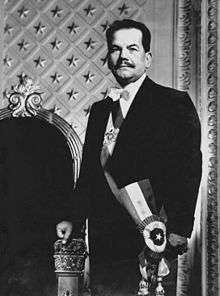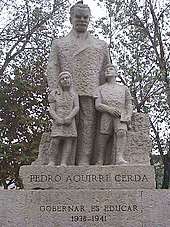Pedro Aguirre Cerda
Pedro Aguirre Cerda (American Spanish: [ˈpeðɾo aˈɣire ˈseɾða]; February 6, 1879 – November 25, 1941) was a Chilean political figure. A member of the Radical Party, he was chosen as the Popular Front's candidate for the 1938 presidential election, and was elected. He governed Chile until his death in 1941. Pedro Aguirre Cerda was of Basque descent.[1]
Pedro Aguirre Cerda | |
|---|---|
 | |
| 22nd President of Chile | |
| In office December 25, 1938 – November 25, 1941 | |
| Vice President | Jerónimo Méndez |
| Preceded by | Arturo Alessandri |
| Succeeded by | Jerónimo Méndez |
| Personal details | |
| Born | February 6, 1879 Pocuro, Chile |
| Died | November 25, 1941 (aged 62) Santiago, Chile |
| Political party | Radical Party |
| Spouse(s) | |
| Signature | |
Early life
He was born in Pocuro, a small village near the city of Los Andes, in Chile. The seventh of eleven children of Juan Bautista Aguirre and Clarisa Cerda. His father, a farmer, died when he was eight years old in 1887. His mother had to run the farm and raise him and all his siblings alone.
He finished his university studies in Santiago, at the Pedagogic Institute and became a teacher of Spanish in 1900. In 1904 he became a lawyer. He married his cousin Juana Rosa Aguirre Luco, with whom he had no children. In 1910, thanks to a government scholarship he studied administrative and financial law at La Sorbonne, plus political economy and social legislation at the College de France. He returned to Chile in 1914 and took a position as a teacher at the Instituto Nacional. He also became president of the National Society of Teachers.
He was a very distinguished teacher, attorney, deputy and senator. He was also the first dean of the new school of economy of the Universidad de Chile. As a member of the Radical Party, he was minister of Public Instruction and of the Interior during the administrations of Juan Luis Sanfuentes and Arturo Alessandri. During the period of military domination, he was persecuted and became an active opposition leader to the government of General Carlos Ibáñez del Campo.
For the 1938 Chilean presidential election, he was the Popular Front candidate, and narrowly defeated conservative candidate Gustavo Ross, mostly because of the political backlash caused by the Seguro Obrero Massacre.
Presidency

Pedro Aguirre Cerda was elected and assumed his duties as president on December 25, 1938 under the slogan "Gobernar es educar" (to govern is to educate.) As a teacher, his priority in government was education. As such, he promoted the development of the technical-industrial schools as a means to promote the formation of technicians for the nascent industrialization of the country. He also created thousands of new regular schools and encouraged the growth of the university system to cover the whole of the country. Aguirre’s government also redistributed some land, encouraged the formation of agricultural settlements, built low-cost housing and schools, and integrated the Marxist parties into the political system.[2]
During his first year he had to face military opposition to his plans, which boiled over with the so-called Ariostazo. He also promoted and campaigned for a Nobel prize for Gabriela Mistral, which only came to fruition under his successor, Juan Antonio Ríos.
On the economic side, and prompted in part by the devastating earthquake of 1939, he created the Production Development Corporation (Corporación de Fomento de la Producción - CORFO) to encourage with subsidies and direct investments an ambitious program of import substitution industrialization. This was the basis for the industrialization of Chile. From there sprung the steel, manufacturing and sugar industries.
In 1941 due to his rapidly escalating illness, he appointed his minister of the Interior, Jerónimo Méndez as vice-president. He died soon after, of tuberculosis, on November 25, 1941 in Santiago, Chile. Méndez served as acting President until Juan Antonio Rios, elected on February 1, 1942, took office on April 2.
Legacy
In the Chilean Antarctic Expedition in 1950–51, the explorers named the Aguirre Passage between Lemaire Island and Danco Coast after Don Pedro Aguirre Cerda.[3]
Salvador Allende, who was one of Aguirre Cerda's close associates and served as Minister of Health in his government, would become president in the early 1970s.
See also
References
- "Archived copy" (PDF). Archived from the original (PDF) on 2013-10-02. Retrieved 2009-08-03.CS1 maint: archived copy as title (link)
- A History of Chile, 1808–1994, by Simon Collier and William F. Sater
-

External links
| Political offices | ||
|---|---|---|
| Preceded by Pedro García de la Huerta |
Minister of the Interior 1920-1921 |
Succeeded by Héctor Arancibia |
| Preceded by Domingo Amunátegui |
Minister of the Interior 1924 |
Succeeded by José Maza |
| Preceded by Cornelio Saavedra Montt |
Minister of the Interior 1924 |
Succeeded by Luis Altamirano |
| Preceded by Arturo Alessandri |
President of Chile 1938-1941 |
Succeeded by Jerónimo Méndez |